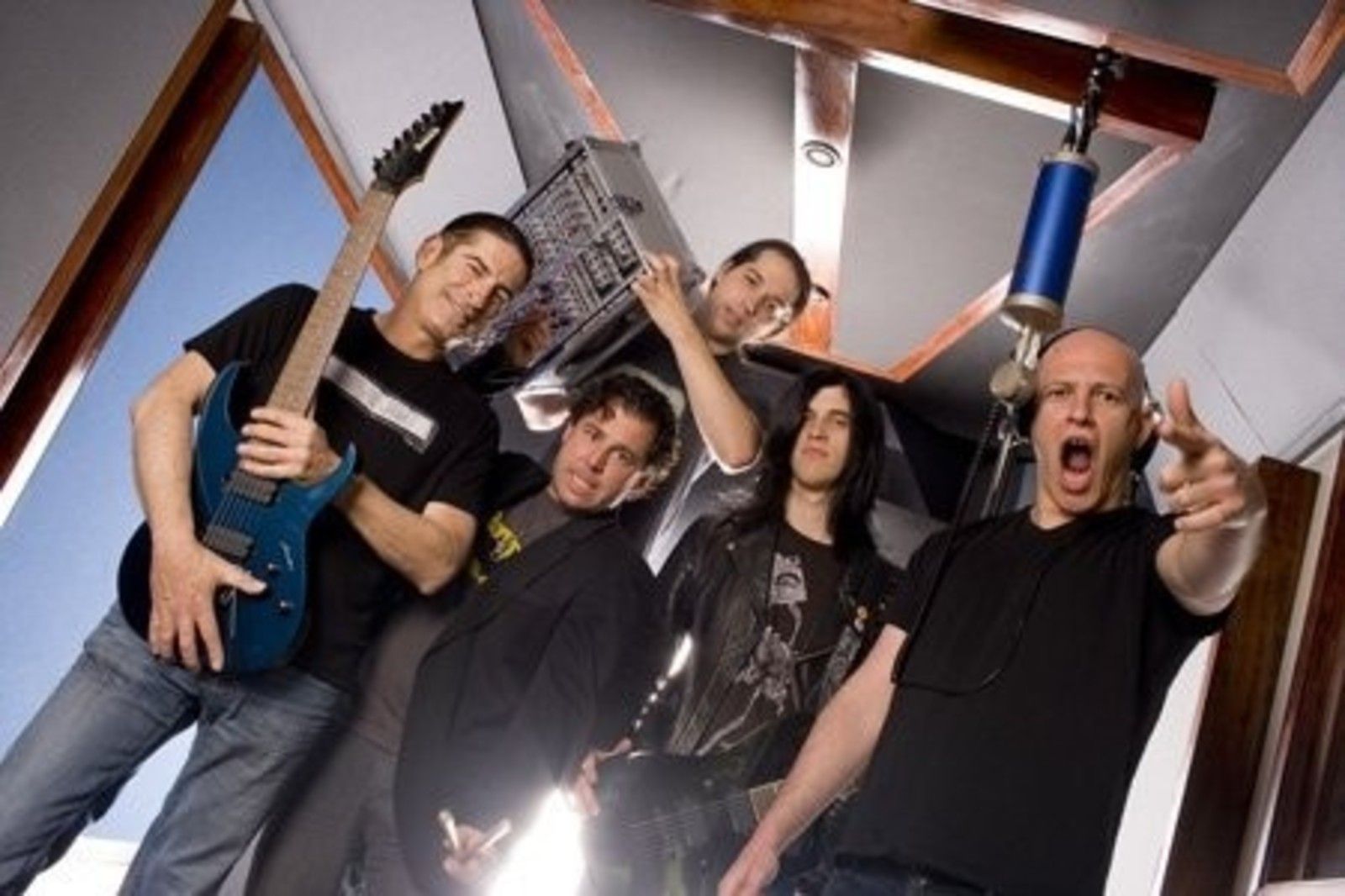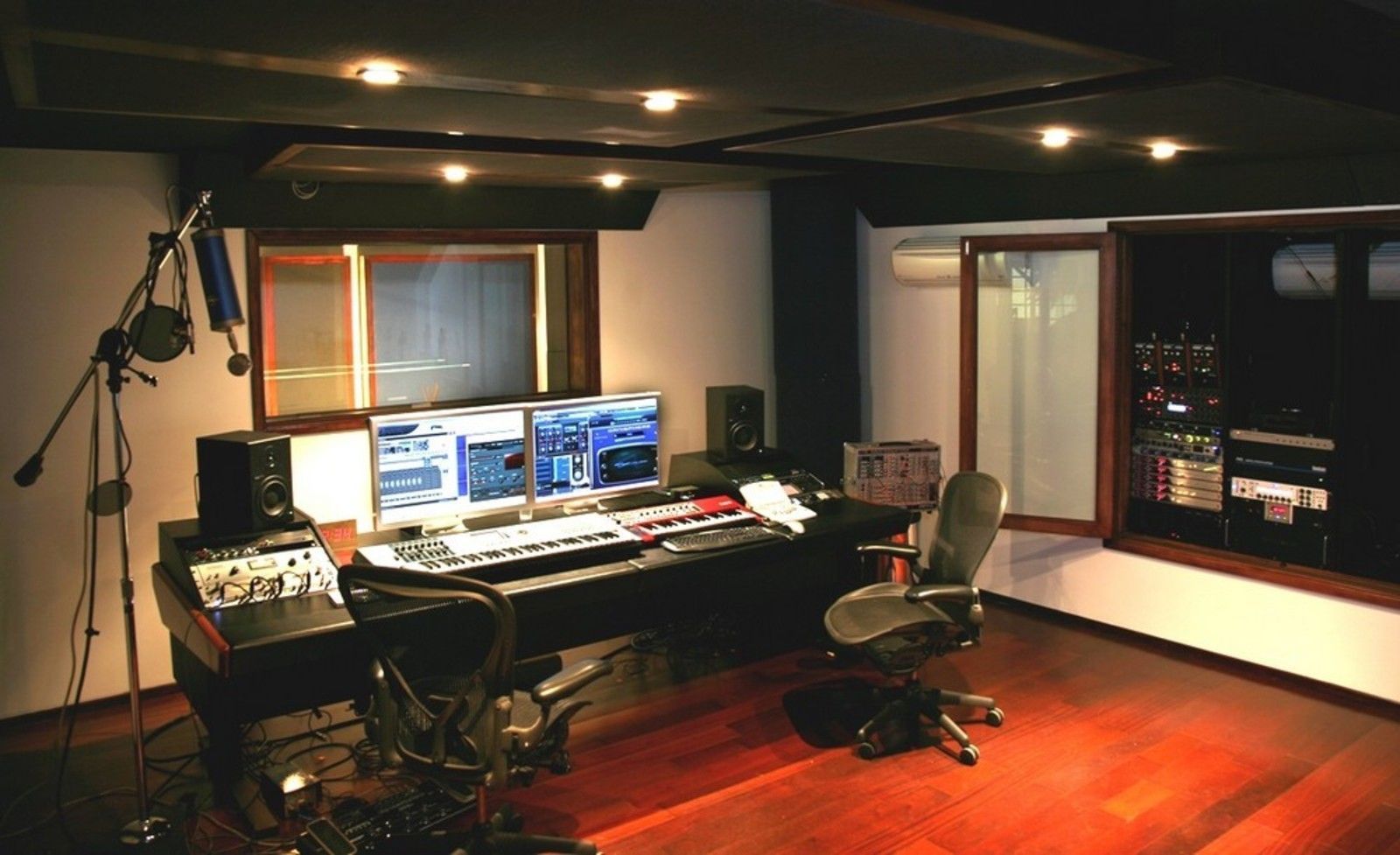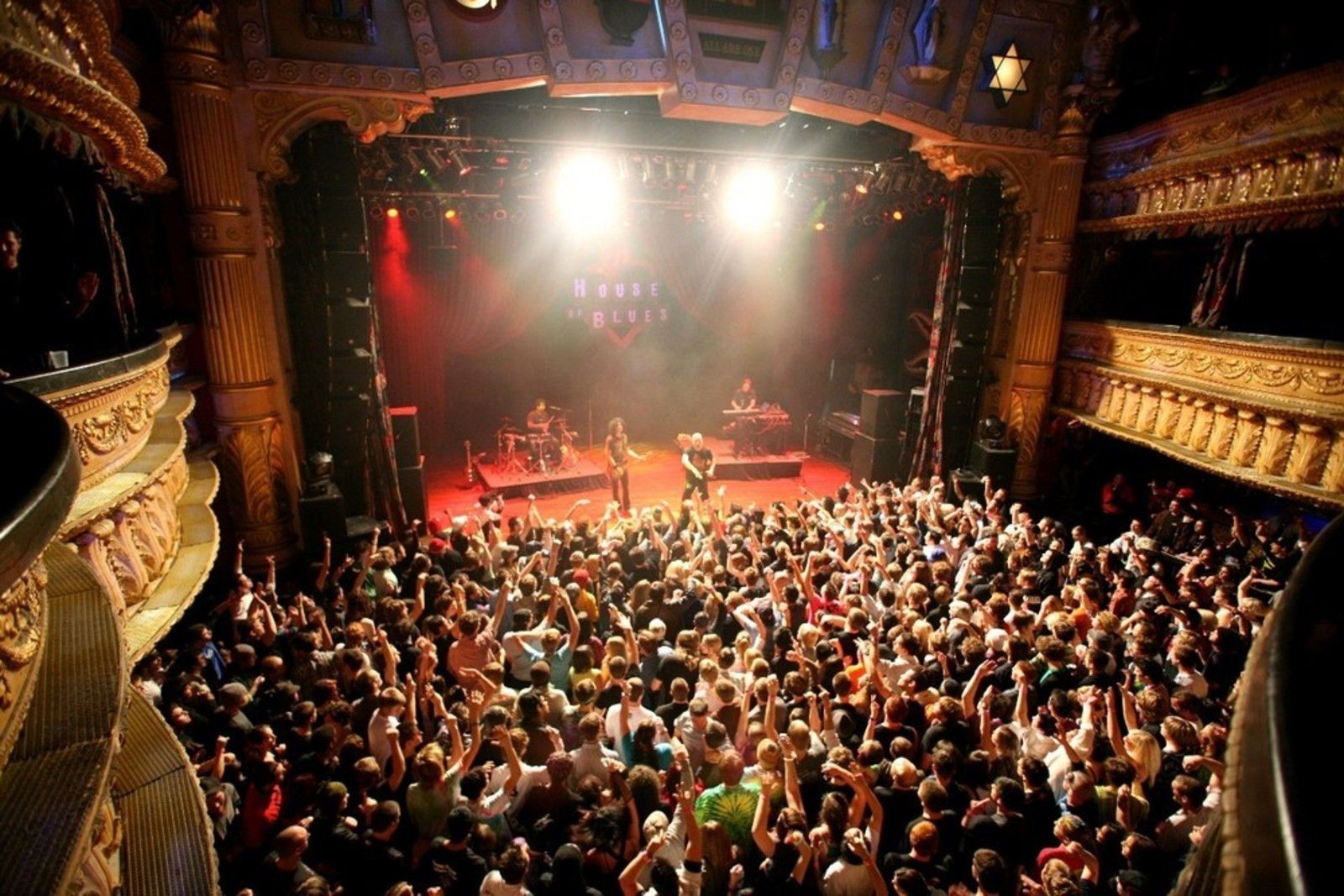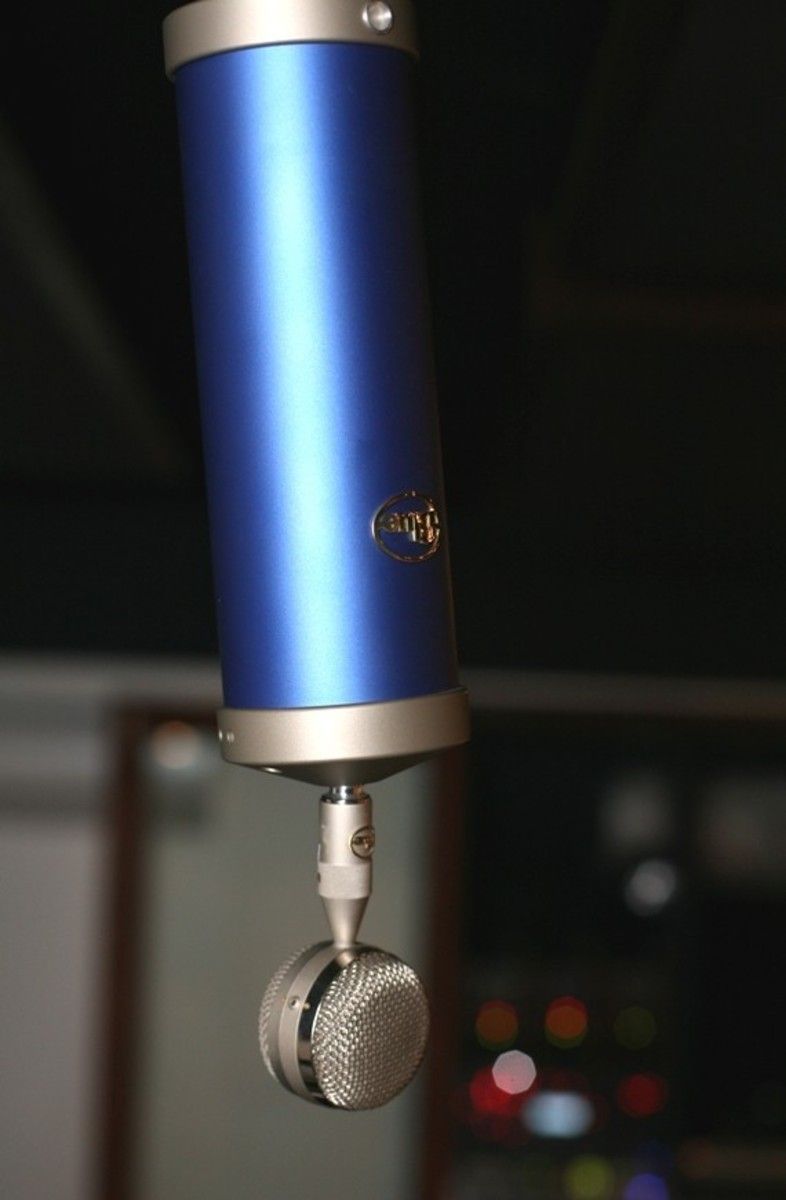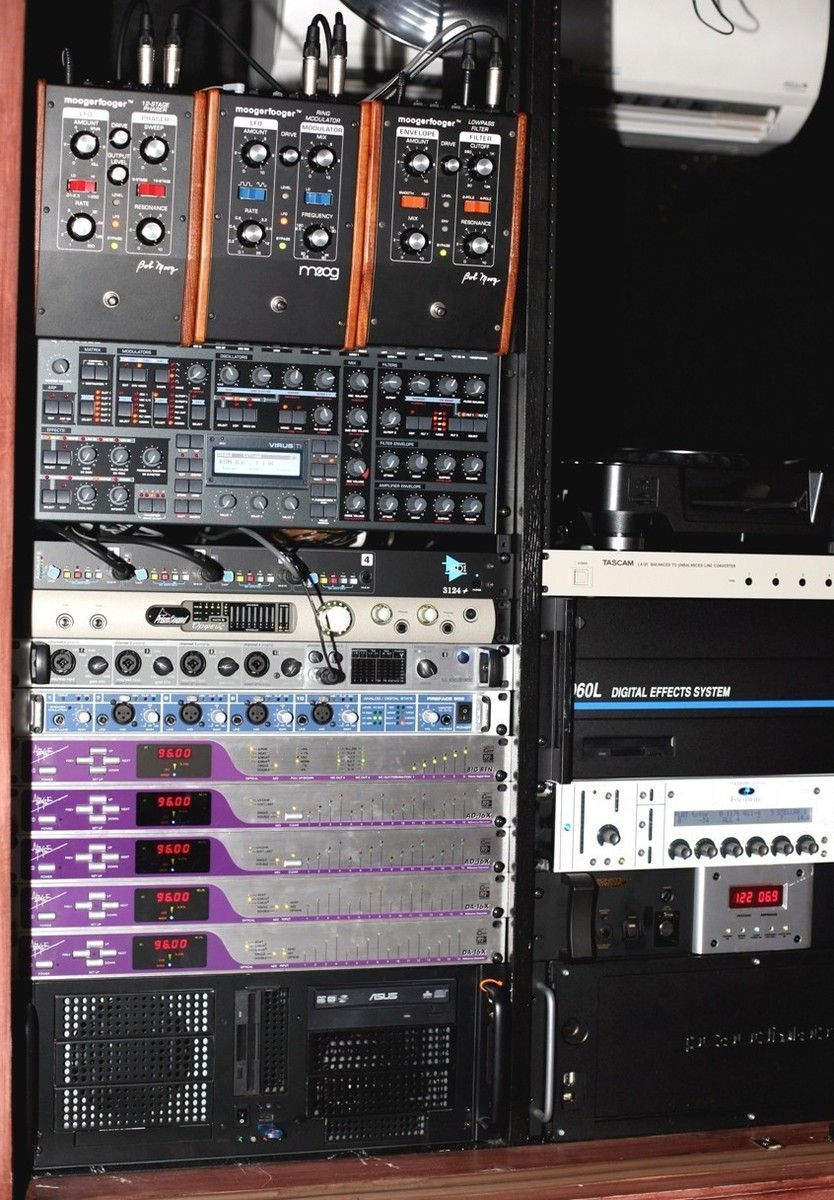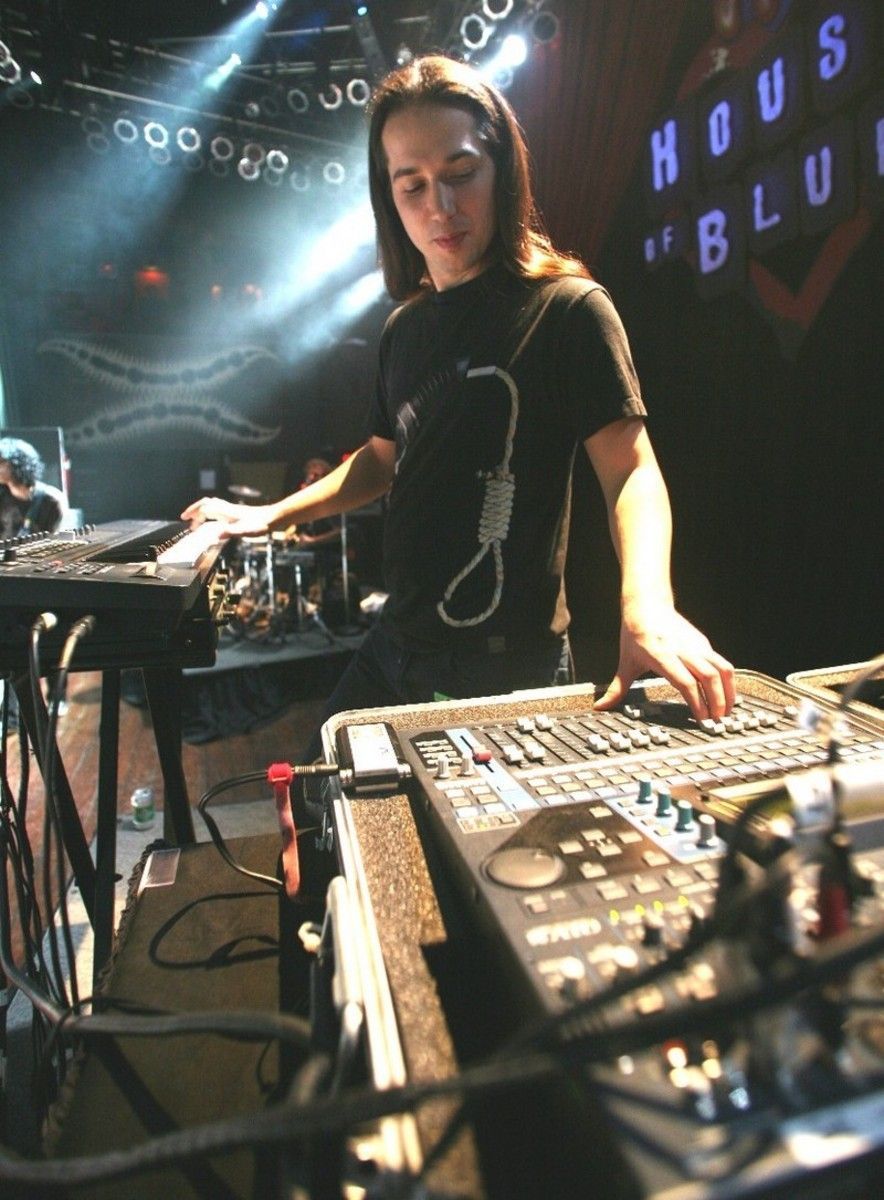Innovators, geek tricksters, obsessive-perfectionists, un-serious, electronic-rock geniuses? Time will tell, yet The Legend of the Black Shawarma, Infected Mushroom’s 7th album release will certainly grab the chair from underneath you and leave you thinking- I’m not sure what was this meticulous musical chaos, but I can’t stop moving even after track has finished.
| Erez Eisen and Amit Duvedevani “Duvdev” (background). |
Innovators, geek tricksters, obsessive-perfectionists, un-serious, electronic-rock geniuses? Time will tell, yet The Legend of the Black Shawarma, Infected Mushroom’s 7th album release will certainly grab the chair from underneath you and leave you thinking- I’m not sure what was this meticulous musical chaos, but I can’t stop moving even after the track has finished.
Hailing from sunny shores of Israel, now based in another sunny city, Los Angeles, the sun always seems to shine in Infected land, the core of which is Erez Eisen and Amit Duvedevani. But seriously, between the hard-earned success, the mess, the nuclear shows, the private jokes you will find two very do-it-yourself kind of musician scientists who write, produce, mix, master, tweak and fix almost every detail of their music.
It was only fitting then that Audiofanzine (AF) will ask the obvious: How do you make that sound? As we brushed off the cobwebs with a morning coffee in Paris, Eisen joined us late at night from his studio in Los Angeles to tell us the production tales of Infected Mushroom. Enjoy.
Part 1: “It’s always changing, you know”
| This is Infected Mushroom today. |
AF: Can you quickly present the band? Who’s doing what?
Eisen: We started- my partner Amit Duvedevani, known as Duvdev, and I, Erez Eisen, in 1996 doing some horrible music. Now today we are like a big band you know, not so big, but we have a drummer named Rogerio Jardim he’s a great drummer from Brazil, he lives in America now. We have an Israeli guitar player Erez Netz, which is considered one of the best electronic guitar players, the best in Israel. We love him. And also Thomas Cunningham, a young kick ass guitar player from America who performs with us. This is Infected Mushroom.
AF: What do you consider to be your influences? You’re using some ‘metal’ gigs and some ‘jazzy organs’ on the same tracks, some hip-hop influences, some Spanish music influences…
Eisen: It’s always changing, you know. It started with electronic like Psytrance bands, which is Simon Posford, known as Shpongle as well, also Hallucinogen. At the time we liked X-Dream, Etnica, many other bands from this genre. These are the main ones. And slowly through the years we became open to everything. We are listening to radio and MTV, not as it is today, horrible, but how it used to be with more heavy metal stuff. Even if it is hip-hop sometimes, a few Jay Zee tracks, it can be nice. Maybe we don’t like the whole concept but we like some ideas. We try to just have fun in the studio basically and to be as creative as we can.
AF: Your style has changed a lot in the past few years. When you go back to your old tracks and you listen to them, what are your thoughts?
Eisen: The Gathering, which is the first album as Infected, I tend to think that is has a few decent tracks for me. I think Tommy the Bat is one of them, and a few others, but the production is horrible. I’m not so proud of it, let’s say. But, you know, I was 16 I think when we did it. So it’s OK.
| Infected Mushroom’s Studio in L.A.: Best place for inspiration. |
AF: Do you begin making a song in your studio or sometimes you need to go to someplace else to get inspired?
Eisen: No, it’s always in the studio. We tried doing tracks on the road, but we never did one. Sometimes we come with just no ideas into the studio and we just decide on a BPM, usually it’s just 145, and we just start kick, bass line, and somehow looking for sounds and stuff. Sometimes we are lucky, everything goes smoothly and we have a track going on very fast, and sometimes we get stuck like a week on a track.
AF: I know what you mean. I have been stuck for 10 years now.
Eisen: When we are stuck, I wanted to kick myself sometimes, I wanted to say “that’s it, I cannot do anymore music, I have no more ideas”, but then Duvdev said “let’s see it as a fight in the studio”, like a video game- there is a level that is really hard to pass, and you keep trying until you move to the next level. So this is how we see it these days and it really helps. For us, when we have these horrible days we just give it a fight. Sometimes it’s the lyrics. Duvdev comes in with lyrics, and from there we get something- which is much easier. Every time it’s something different.
| Infected Mushroom Live in Chicago 11/14/09 |
AF: What would you consider to be your biggest challenge as a band?
Eisen: We always have challenges. I guess the first big challenge was to make the band happen, to find the guitar player, to find the drummer, to write the parts for them, because the tracks are already kind of busy for us, and we didn’t want to make it noisy for the live show. It’s kind of hard, in the beginning, to think about what the guitar player would play that will not sound too busy, and how to add a drummer that will not create too much of a mess.
AF: In the studio you can create and produce music under ideal conditions. It then becomes a challenge to re-create that sound on stage. How do you approach that?
Eisen: Yeah, for stage we try to have a little bit more bass, this feeling that you have a big speaker and you want to feel the bass, not just hear it. This is very important. And for the rest of the frequencies we try to make it as good as we can compared to what we had in mind in the studio- which never happens, by the way. With our luck, we go to horrible sound systems most of the time. It’s always a challenge to do a proper sound check.
Part 2: “I hate compression”: Gear and Sound Design Technique
|
Digital Mixers Digital Synth Racks/Sound Modules Digital to Analog Converters DSP Boards Dynamic Processors Empirical Labs Distressor – EL8-X Lev Solutions Dual Vactec Compressor External Audio Interfaces TC Electronic StudioKonnekt 48 Filters Moog Music MF-101 Lowpass Filter General Sequencers Internal PCI/ISA Sound Cards Sonic Core scope professionnel MIDI Interfaces MIDI Keyboard Controllers Multi-Effects for Electric Guitar Other Computers Other Effects Processors Phasers Moog Music MF-103 12-Stage Phaser Pre-amplification Reverbs Ring Modulators Moog Music MF-102 Ring Modulator Solid-State Pre-amps Synchronizers Virtual Basses Virtual Samplers/Sample Players Workstations |
AF: Now I would like to ask you, because you know Audiofanzine is really gear-addicts-oriented and you have some…you will probably not tell us all your secrets but…
Eisen: I will tell you everything. I don’t keep any secrets. It’s all good.
AF: That’s good. So first I have a few general questions about your gear. Actually, if you have a full list of your gear that would be interesting to know, maybe you can send it to us?
Eisen: Absolutely. [see right column]
| The Blue Microphone |
AF: I see that you have a Blue Microphone, how did you choose this one?
Eisen: We have two Blue mics and a Blue Bottle. When we were in Israel, we had a lot of luck finding a guy that had all these old school mics, including the high end Neumann and special Telefunken. Very good mics. The way I learned that I have to do tests is, I call it the blind test. You record WAV files and then you just choose whichever sounds best. No matter what it is, you have to go with it. So we tested let’s say 5 mics, and the Blue sounded the best for us – in everything.
AF: Seems to be a good way to choose.
Eisen: This is always what we do. Sadly, we sometimes find out that we spend money on, for example, expensive compressors, and at the end we find that a plug-in sounded better. Which is annoying, but if it sounds better, it sounds better.
| Left Rack: Includes the Avalon AD2022 & Teletronix LA-2A |
AF: I see that you have an Avalon pre-amp. How do you usually use it on individual instruments, like on guitars, synths?
Eisen: The Avalon pre-amp we use for synths, so we plug some synths to the Avalon – it just sounds so much better than connecting it directly, of course with unbalanced cables. We use it also for guitar recordings. It’s the same as the synths basically, I am just connecting the output to the Zoom effects processor for guitars.
AF: The G7?
Eisen: In the studio we use the G9 actually. It’s the same, almost the same. We connect it directly to that and it sounds great. The only negative thing I have to say about it is that it gets distorted pretty fast. Unlike the Neve 1073. But it still sounds good. If it’s not distorted, it sounds really really good.
AF: I’ve seen pictures of your home studio 6 or 7 years ago and now you have bigger one in L.A., but you still use the Dynaudio BM6A. I have the same pair for 7 years as well. They are good but kind of aggressive in the high pitched sounds. You never wanted to upgrade to another kind of speaker?
Eisen: The thing is we had lots of monitors in the past, and again, we also had the Dynaudio BM15 and also the… I don’t remember the model, it has two woofers and one tweeter, it’s really expensive like $6000. We said let’s try, and it didn’t sound as good. The mix didn’t come out as good as we had on the BM6A. So we said fuck it, it sounds good enough. Maybe we are going to change in the future, I know there are a few monitors which are supposed to sound much better for mixing, like the Adam I heard good stuff about.
AF: And you are used to these ones, so your ears know perfectly how they work…
Eisen: We’ve used them for so many years. I can throw these speakers into almost any room and get a decent mix.
AF: Do you have a second pair for mixing?
Eisen: No. I hate this system. We used to try that as well, it just confuses me. I cannot mix like that.
| Right Rack. |
AF: What compressor or limiter do you use on the final mixes? Because your tracks don’t sound so compressed compared to other electronic music songs.
Eisen: We don’t use compression at all in the final mix.
AF: Ok. Interesting.
Eisen: I mean, this is our- let’s say- our secret. Big secret. We do the mastering ourselves as well. We basically learned that if we push the gain really high and get everything distorted in a way that you don’t hear distortion, you just see the red really really – say 6db+ you don’t hear distortion yet and we record that analog to another convertor then we get much better sound. We tried even the Waves Ultramaximizer- I don’t find them sounding better than what we do. I find the Waves, for example, taking away the highs a little bit. And not only Waves, a lot of other companies that do the same things. The highs always go away, and something in the details goes away. This way, we record it analog, in our case we record it to the Prism Sound, and we get the Prism Sound distorted ['visually’. So the inputs are distorted and the meter shows that it cliping but my ears don’t hear distortion]. We get really high gain and with a sound that doesn’t sound compressed.
| Main Rack. |
AF: Yeah definitely, if you have more dynamics that’s better.
Eisen: I hate compression. If I can avoid it, I prefer to avoid the compression. Especially side chain compression.
AF: It’s good to hear that because you know more and more people just compress and over-compress…
Eisen: I don’t understand why. They forget about the music. Where is the music? But then again, it’s a matter of taste. Everybody does what feels better to them.
AF: So do you mix everything in Cubase?
Eisen: Yes, we do, we mix everything in Cubase. We are actually spreading the channels on the RME AES32 mixer, so we do the sounding over there in a way. I think it sounds better, and then we record the two outputs to two inputs of another soundcard, the Prism Sound.
AF: What are your preferred virtual synths?
Eisen: I used to say lots of stuff but I think these days I think only Omnisphere. It’s absolutely amazing and we also have Trilian, which is really really good. We bought the whole Native Instruments pack for example, and I want to say Massive – it is an amazing synth, but it doesn’t work on Cubase properly.
AF: You mean it crashes?
Eisen: Always crashes. Massive, sometimes when we really want to have a different sound, we use Massive on another computers stand alone, sadly. I think these are the best VSTs. I don’t think there is anything else that can compare to the Spectrasonics stuff, in terms of everything. And we also have for strings the Vienna Symphonic Library, the plug-in VSL.
AF: In one of your songs there is a violin, playing really like a violin, is that what you use?
Eisen: Yes. This is what we use.
AF: I thought it was a real one.
Eisen: It’s expensive shit, the Vienna, really expensive, but nothing compares to it. It sounds so realistic. And if you write it in the right way, it’s unbelievable. The Vienna is amazing. Even the built in Cubase 5 plug-ins are sounding really good. The synths themselves, the sound quality is good.
| Eisen 'doing the mixing for the live’ |
AF: Now what about the hardware gear you use mostly when you play live?
Eisen: Well it’s very simple. As a synth, I use only the Motif XS6. Controlling it with the Edirol PCR-800. It’s pretty good. I control the cutoff with the Boss Volume pedal. For a mixer we use the Yamaha 01V96 version 2. Which is great, in the live show we just push the button and 99% of the soundcheck is done. The only thing I have left to do is just final EQ for the system, and that’s it.
AF: Very practical.
Eisen: I am also controlling the mixer from my midi controller from the Edirol keyboard. So if I need more guitars I don’t need to approach the mixer, I just push more guitars…I have everything controlled from the keyboard. Everything is really quick in the live show, because I am doing the mixing for the live.
AF: And on the computer part you never had any crashes while playing live?
Eisen: We did a long time ago because of our mistakes. We had the stupidity having by mistake an anti-virus open and it decided to look for an update or something. Today we have a backup for everything almost. But we don’t have crashes for many years now luckily.
AF: A few minutes ago we were talking about your mixes. They are always very 'precise’, with no redundancies on the spectrum, even when you have big synths playing. For example, I read in your forum that you said “the hard work is to mix things right and remove unwanted frequencies”. Would you reduce the spectrum of most of your instruments when mixing to reach this goal?
Eisen: I high-filter everything except the bass and the kick drum. Actually I made a plug-in in Reaktor that solved the issue of kick and bass. I basically made the side chain EQ in a way. Every time there is a kick, there is a high-pass filter on the bass line for example. Every time the kick plays, the bass line has a high-pass. I used to do it manually. Then I said, you know what, let’s do it in Reaktor, it’s pretty easy.
AF: It’s really working well. The bass and drums are really always very precise.
Eisen: You just clean the mix. Whenever the kick doesn’t play, it still sounds fat. Especially if you always want to have bass playing on the kick at the same time. That’s the biggest problem – you just find yourself doing a bass line that you don’t really want. Bassline without the ones on the kick. For me at least, we solved this issue for Infected. Except that, I low cut everything that doesn’t need bass, unless it’s a break, and in the break you can bring back all the bass. But when the kick comes, I think most of the mix sounds cleaner when you cut at least 100–120 Hz. Much clearer.
There are so many techniques that I use – stereo synth, so that the synth will sound more stereo. I am doing a technique of double tracking like on guitar. Basically let’s say I have a simple bass line. So I play a little bit with the cutoff, I play a little bit with the attack, with the decay, a little bit with the release of the sound. I am doing a long session that I am playing with it. Like let’s say, 8 bars, ok. And then from these 8 bars I export the 8 bars to an audio file, and then I split the 8 bars to 4 and 4. The first 4 I put on the left channel, and second 4 I put on the right channel. And then I have this small movement in the bass line, and I recorded the movement manually so it’s not so precise. The left channel is not exactly as the right channel and then it sounds more stereo without any effect.
AF: Like a chorus.
Eisen: Yeah like a chorus. But if you wanted to sound more like a chorus you play also with the tune, the off-tune.
AF: This sounds like you really have two players at the same time.
Eisen: Yeah. It sounds like two players at the same time. You don’t really know what is going on, but it sounds more stereo and more fat in a way. So I am doing it almost for everything, to be honest. Almost any end that we do – we just record a longer version, then we cut it in the middle. The first part we put left, the second part right, and that’s it.
AF: Very interesting for our readers, these kinds of tricks.
Eisen: I have so many, I don’t know where to start, I don’t want to bore you to death.
AF: I won’t be bored even if we talk all day. ;-)
Part 3: The Legend of the Black Shawarma
AF: I am going to play the intro from Poquito Mas. The first 10 seconds you have an acoustic guitar which kind of drops and gets pitch shifted as if you were about to scratch on it. I am interested to know how you make that sound -it gets pitch shifted but not exactly like a pitch shift.
[Poquito Mas Guitar Intro]

Eisen: Basically what I do in many things is, I take, let’s say, one note from the guitar part and I just apply an effect on it. This pitch shift if I am not wrong is Soundforge because I hate the pitch shift on Cubase. So I take it to Soundforge just to pitch shift and I paint how low I want the pitch shift to go. It’s really easy on Soundforge to do that. And then I take this part of the wave and bring it back in time, and just put it in this second. If I want a trigger, I just mark a small part, I loop the small trigger, it can be a few samples even. I try to avoid clicks when I’m doing it, looking for zero crossing. Then I just do the trigger and put it in the right time.
AF: What delay do you use? It sounds like a delay with a filter on it, it’s a plug-in?
Eisen: Actually it’s a delay that I made.
AF: I have the Lexicon MPX-1 and it reminds me of one of the effects on it. It’s really nice. To mix a filter on the delay.
Eisen: It’s an 8 tap delay on it, and on each tap there you can add any effect that you want.
AF: On the guitar, just after the intro, you have an amp effect. You said you are not using guitar amps.
Eisen: No. Not at all.
AF: So the effects that you are using…
Eisen: On this specific guitar, it’s basically going to the Avalon clean and from the Avalon it actually goes to an LA2A, a real one, a little bit compression. I think for highs, to make the guitar brighter, I use the Pultec UAD plug-in. I love the high frequencies in the Pultec. Usually I just choose the highest settings.
AF: On Sa’eed, the beginning percussion parts, is it your drummer who is playing?
[Sa’eed Percussion Intro]

Eisen: The percussions here are actually just tapping on an acoustic guitar.
AF: Really?
Eisen: Yeah with the fingers, just tapping on the body of the guitar and using the same stereo technique that we talked about before. The percussion of the whole thing is using an acoustic guitar, just drumming on the guitar. It sounded pretty cool. We didn’t expect to use it. I don’t know how it sounded like that. We just tried it, and the mic was really close to the tapping, and it sounds like that.
AF: Sometimes you have surprises.
Eisen: Always good stuff is by surprise.
AF: At 1:00 you have some effect on the voice. How do you make this kind of sound on the voice?
[Sa’eed Vocals]

Eisen: Basically, we cut every syllable of the word. Let’s say “I feel ashamed”, we cut the “I” and then in the word “feel” we just cut the “f”, the “ee”, and then the “l”. For example, only the “ee” of the “feel” we trigger that one. A really small trigger until we get the pitch, the note that we want.
AF: Yes. Because when you do a loop on it makes special harmonics.
[Editor’s Note : the sound is tuned depending on the length of the loop : frequency (in Hz) = 1 / period of the loop (in seconds) – example : To reach a 440 Hz “A”, your loop has to be a multiple of 2.2727 milliseconds]
Eisen: Yeah. When it’s really short you get these special harmonics. So you need to know the length of the loop that you are doing until you get the right pitch. Basically we do this on every syllable. On “ashamed” there are a lot of them. Usually, on the “s”, the “t” and the “d”, the beginnings of words, the consonants, we keep, we don’t touch them, and only harmonics sound we trigger. It takes a lot of time.
AF: I thought it was a plug-in that was doing that. So you are doing that manually.
Eisen: I hope there is a plug-in. Please give it to me. This is what we do. We did it a long time ago on a track called I Wish. This was the first time we tried doing it – on the album Converting Vegetarians. We did it here again, but only difference is that we put this one through a small distortion. We actually did it because we didn’t have the time to remove all the clicks. We were lazy. When you sample a voice with clicks through distortion, it doesn’t sound like with clicks anymore.
AF: You know Depeche Mode, right? Do you feel some cross influence sometimes?
Eisen: Of course. Listen, we are big Depeche Mode fans. We are very influenced by them. Even from Cities of the Future. It’s very, umm, trying to be Depeche Mode in a way. Sadly we are far from that.
AF: It’s really creative, very different, but we can feel the influence somehow.
Eisen: We like the chord changes of Depeche Mode, and also the way they do stuff is really unique and nice. So we try to do it in our own way but obviously everybody can hear that it’s, you know, stolen from Depeche Mode.
AF: Not stolen but influenced. Now on Project 100, there is a very nice Rhodes piano. Is it a plug-in that you are using?
[Project 100 Piano]

Eisen: No. It’s just the Motif XS.
AF: And do you play any specific effect on it? Like an AM/FM modulator on it?
Eisen: There is a fast LFO, I think the LFO is on the panning, if I am not wrong.
AF: OK so once again it is manual work on the sound, as opposed to a preset. On [the song] Franks, in the beginning there are some really cool chords, like some mean EQ and some overdrive. Let’s listen to it.
[Franks Intro]

AF: So once again, what instrument and what effect do you use?
Eisen: I think it’s also the Motif XS going through distortion. This distortion is not that great. Actually it’s with the Cubase amp simulator. I added this onto the Motif sound, but I don’t remember what style of sound it is.
AF: The big thing in this record is your collaborations with Jonathan Davis, Perry Farrell and the Doors. Is this something that you’ve wanted to do for a long time, collaborate with other artists? And what was their contribution?
Eisen: We can start with the Doors. It was the Doors track that Warner Brothers requested us to remix. They did a remix CD for many Doors tracks, and basically we got approved to use it in our album – The Riders on the Storm. We got original channels from the Doors which was really exciting to get all these cool recordings, which sounded pretty good I must say. This was the easiest one because it was pre-recorded so we didn’t really collaborate.
With Jonathan Davis from Korn, in the beginning we asked him which song he wanted to sing. He chose Killing Time in the beginning. He came to the studio and we said, ‘do you mind trying Smashing the Opponent because we think it fits more to your style’. And he said ‘sure’. He didn’t practice it, but we just printed the lyrics, he gave it a shot, and I think not more than one hour recording and it was done, the vocals.
AF: So basically, the lyrics and the melody lines were written and he just performed them?
Eisen: Yeah. Everything was written before. He just came and performed the vocals. Same for Jane’s Addiction singer, Perry Farrell. We asked him if he minds doing Killing Time, and he liked it. With him we did two different sessions. We bothered him twice. Actually, he knows us for a long time. He has Classical Mushroom EP and The Gathering, which was very weird for us. Like, why do you have these albums? It was pretty fun.
Our move to Los Angeles was the move to make collaborations with people. In Israel we were pretty limited to Israeli artists, which I have nothing against. But it’s limited to Hebrew mainly. We have dreams, as kids, you want to work with big artists, and you never believe that you will be able to do, so we said let’s try. We almost got Dave Ghan from Depeche Mode singing, but at the end it didn’t happen. Hopefully, it will happen with Dave in the next album.
| Duvdev and Eisen: Serving up The Legend of the Black Shawarma to legions of 'converted vegetarians’. |
AF: Last question about your lyrics from [the track] “The Legend of the Black Shawarma”, they are very positive and they are almost sending a message but maybe with a little bit of a warning. I am assuming these are not totally random lyrics, is this something that you’ve realized with time and now you wish to share with your listeners?
Eisen: When we started doing lyrics, we said we will write about everything except about love. Because, it’s not that we have anything against love, but every song is about love. So we said everything but love, which was not so hard. And slowly it became the Duvdev road, most of the lyrics. He came into the studio with almost all of the lyrics and maybe I didn’t like one or two words. Duvdev is a pretty crazy guy. He has lots of weird ideas. Lots of them we cannot even write about. We try to write stuff with less meaning, that will open people to think about stuff. Or we write very un-serious lyrics that it’s just private jokes between us and our friends. So please don’t take our lyrics seriously.
AF: So you mean that actually you don’t want to convert vegetarians for real?
Eisen: Why not? No, I’m just kidding… Everything is just funny, don’t take it too seriously. Converting vegetarians, if there is a meaning it’s mostly meaning: convert yourself from listening to regular music and be open to listen to other kinds of music.
This interview took place on November 17, 2009 9:00 am Paris time between Philippe Raynaud (AF Paris), Sarit Zadok (AF Jerusalem), Erez Eisen (Infected Mushroom LA). Special thanks to Reuven Mansharoff of Musical Act Magazine www.act.co.il .


